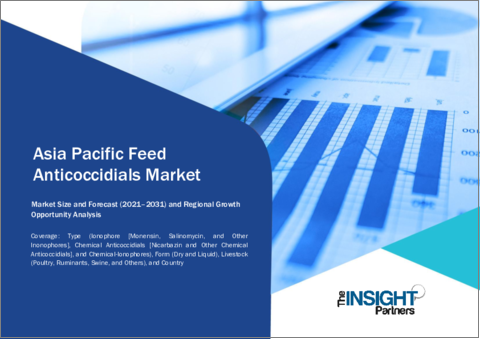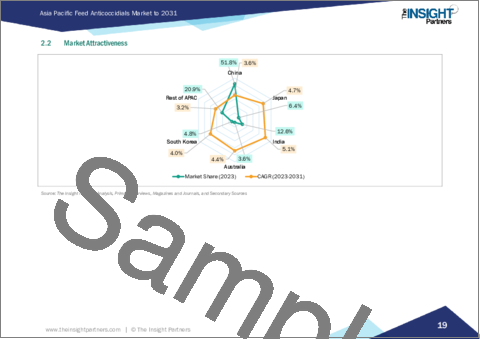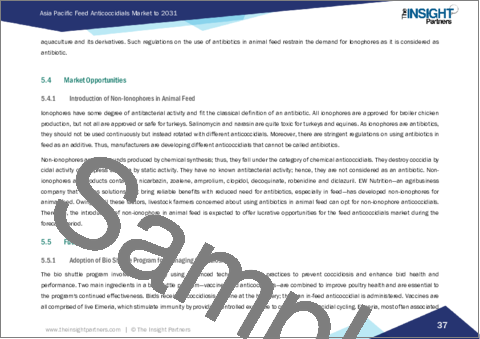|
|
市場調査レポート
商品コード
1764959
アジア太平洋の飼料用抗コクシジウム剤市場の2031年までの予測-地域別分析-タイプ別、形態別、家畜別Asia Pacific Feed Anticoccidials Market Forecast to 2031 - Regional Analysis - by Type (Ionophore, Chemical Anticoccidials, and Chemical-Ionophores), Form (Dry and Liquid), and Livestock (Poultry, Ruminants, Swine, and Others) |
||||||
|
|||||||
| アジア太平洋の飼料用抗コクシジウム剤市場の2031年までの予測-地域別分析-タイプ別、形態別、家畜別 |
|
出版日: 2025年04月14日
発行: The Insight Partners
ページ情報: 英文 129 Pages
納期: 即納可能
|
全表示
- 概要
- 図表
- 目次
アジア太平洋の飼料用抗コクシジウム剤市場は、2023年に4億8,272万米ドルと評価され、2031年には6億5,092万米ドルに達すると予測され、2023~2031年にかけて3.8%のCAGRを記録すると予測されています。
動物飼料への非イオン剤の導入がアジア太平洋の飼料用抗コクシジウム剤市場を押し上げる
イオノフォアはある程度の抗菌活性を持ち、古典的な抗生物質の定義に当てはまる。全てのイオノフォアはブロイラー用として認可されているが、トルコ用としては認可されていないです。サリノマイシンとナラシンは、トルコとウマに対してかなりの毒性があります。イオノフォアは抗生物質であるため、継続的に使用するのではなく、異なる抗コクシジウム剤とローテーションで使用する必要があります。さらに、飼料に添加物として抗生物質を使用することには厳しい規制があります。そのため、メーカーは抗生物質とは呼べないによる抗コクシジウム剤を開発しています。
非アイオノフォアは化学合成によって製造される化合物であり、化学的抗コクシジウム剤に分類されます。殺ダニ活性でコクシジウムを破壊し、静菌活性でコクシジウムを抑制します。抗菌活性は知られていないため、抗生物質とはみなされないです。ニカルバジン、ゾアレン、アンプロリウム、クロピドール、デコキネート、ロベニジン、ジクラズリルなどが含まれます。EWニュートリションは、特に飼料における抗生物質の必要性を減らし、確実な利益をもたらすソリューションを開発するアグリビジネス企業で、動物飼料用の非イオノフォアを開発しました。これらの要因により、飼料に抗生物質を使用することを懸念する畜産農業従事者は、非イオンフォア系抗コクシジウム剤を選択することができます。したがって、動物飼料への非イオンホアの導入は、予測期間中、飼料用抗コクシジウム剤市場に有利な機会を提供すると予想されます。
アジア太平洋の飼料用抗コクシジウム剤市場概要
中国は豚肉と家禽の最大生産国の1つであり、動物の健康と成長率に影響を与えるコクシジウムのような疾病に対する効果的な防除対策を構築しています。集約的農業経営におけるコクシジウム症の発生は、経済的損失を軽減する上で飼料用抗コクシジウム剤の採用を極めて重要なものにしています。これらの損失は、飼料変換効率の低下、体重増加率の低下、感染した動物の死亡率の増加によって発生します。
中国政府は食品の安全性と品質に重点を置いており、これが飼料用抗コクシジウム剤市場を後押ししています。農業農村部(MARA)などの規制機関は、動物用医薬品や飼料添加物の使用について厳格なガイドラインを定めており、抗コクシジウム製品の安全性と有効性を確保しています。さらに、中国では天然で非化学的な抗コクシジウム剤の使用動向が高まっています。
アジア太平洋の飼料用抗コクシジウム剤市場の収益と2031年までの予測(金額)
アジア太平洋の飼料用抗コクシジウム剤市場のセグメンテーション
アジア太平洋の飼料用抗コクシジウム剤市場は、タイプ、形態、家畜、国によって区分されます。タイプ別では、アジア太平洋の飼料用抗コクシジウム剤市場はイオノフォア、化学抗コクシジウム剤、化学イオノフォアに区分されます。2023年にはイオノフォアセグメントが最大の市場シェアを占めています。
形態では、アジア太平洋の飼料用抗コクシジウム剤市場は乾燥と液体に二分されます。2023年には乾燥セグメントがより大きな市場シェアを占めました。
家畜別では、アジア太平洋の飼料用抗コクシジウム剤市場は家禽、反芻動物、豚、その他に区分されます。家禽セグメントが2023年に最大の市場シェアを占めました。
国別に見ると、アジア太平洋の飼料用抗コクシジウム剤市場は、中国、日本、インド、オーストラリア、韓国、その他のアジア太平洋のに区分されます。2023年には中国がアジア太平洋の飼料用抗コクシジウム剤市場シェアを独占しました。
Phibro Animal Health Corp、Zoetis Inc、Kemin Industries Inc、Elanco Animal Health Inc、Innovista Feeding Solutions Pvt Ltd、Huvepharma EOOD、Impextraco NV、Virbac SA.、International Animal Health Products Pty Ltd、Zamira Australia Ltd.は、アジア太平洋の飼料用抗コクシジウム剤市場で事業を展開する大手企業の一部です。
目次
第1章 イントロダクション
第2章 エグゼクティブサマリー
- 主要市場洞察
- 市場の魅力
第3章 調査手法
- 二次調査
- 一次調査
- 仮説の策定
- マクロ経済要因分析
- ファンデーション数値の開発
- データの三角測量
- 国レベルのデータ
- 限界と仮定
第4章 アジア太平洋の飼料用抗コクシジウム剤市場情勢
- 市場概要
- ポーターのファイブフォース分析
- 供給企業の交渉力
- 買い手の交渉力
- 新規参入業者の脅威
- 競争企業間の敵対関係
- 代替品の脅威
- エコシステム分析
- 原料サプライヤー
- 製造プロセス
- 流通業者または供給業者
- 最終用途産業
第5章 アジア太平洋の飼料用抗コクシジウム剤市場:主要市場力学
- 飼料用抗コクシジウム剤市場-主要市場力学
- 市場促進要因
- 家畜生産の増加
- コクシジウム症の流行増加
- 市場抑制要因
- 飼料中の抗生物質使用に対する厳しい規制
- 市場機会
- 動物飼料への非イオノフォアの導入
- 今後の動向
- コクシジウム症管理のためのバイオシャトルプログラムの採用
- 促進要因と抑制要因の影響
第6章 飼料用抗コクシジウム剤市場:アジア太平洋市場分析
- アジア太平洋の飼料用抗コクシジウム剤市場概要
- 飼料用抗コクシジウム剤の市場収益(2021~2031年)
- 飼料用抗コクシジウム剤の市場予測分析
第7章 アジア太平洋の飼料用抗コクシジウム剤市場分析-タイプ別
- イオノフォア
- 化学抗コクシジウム剤
- 化学イオノフォア
第8章 アジア太平洋の飼料用抗コクシジウム剤市場分析-形態別
- 乾燥
- 液体
第9章 アジア太平洋の飼料用抗コクシジウム剤市場分析-家畜別
- 家禽
- 反芻動物
- 豚
- その他
第10章 アジア太平洋の飼料用抗コクシジウム剤市場:国別分析
- アジア太平洋
- 中国
- 日本
- インド
- オーストラリア
- 韓国
- その他のアジア太平洋
第11章 競合情勢
- 企業のポジショニングと集中度
- ヒートマップ分析
第12章 企業プロファイル
- Phibro Animal Health Corp
- Zoetis Inc
- Kemin Industries Inc
- Elanco Animal Health Inc
- Huvepharma EOOD
- Innovista Feeding Solutions Pvt Ltd
- Impextraco NV
- Virbac SA
- International Animal Health Products Pty Ltd
- Zamira Australia Ltd
第13章 付録
List Of Tables
- Table 1. Feed Anticoccidials Market Segmentation
- Table 2. Feed Anticoccidials Market - Revenue and Forecast to 2031 (US$ Million)
- Table 3. Feed Anticoccidials Market - Revenue and Forecast to 2031 (US$ Million) - by Type
- Table 4. Feed Anticoccidials Market - Revenue and Forecast to 2031 (US$ Million) - by Form
- Table 5. Feed Anticoccidials Market - Revenue and Forecast to 2031 (US$ Million) - by Livestock
- Table 6. Asia Pacific: Feed Anticoccidials Market - Revenue and Forecast to 2031 (US$ Million) - by Country
- Table 7. China: Feed Anticoccidials Market - Revenue and Forecast to 2031 (US$ Million) - by Type
- Table 8. China: Feed Anticoccidials Market - Revenue and Forecast to 2031 (US$ Million) - by Form
- Table 9. China: Feed Anticoccidials Market - Revenue and Forecast to 2031 (US$ Million) - by Livestock
- Table 10. Japan: Feed Anticoccidials Market - Revenue and Forecast to 2031 (US$ Million) - by Type
- Table 11. Japan: Feed Anticoccidials Market - Revenue and Forecast to 2031 (US$ Million) - by Form
- Table 12. Japan: Feed Anticoccidials Market - Revenue and Forecast to 2031 (US$ Million) - by Livestock
- Table 13. India: Feed Anticoccidials Market - Revenue and Forecast to 2031 (US$ Million) - by Type
- Table 14. India: Feed Anticoccidials Market - Revenue and Forecast to 2031 (US$ Million) - by Form
- Table 15. India: Feed Anticoccidials Market - Revenue and Forecast to 2031 (US$ Million) - by Livestock
- Table 16. Australia: Feed Anticoccidials Market - Revenue and Forecast to 2031 (US$ Million) - by Type
- Table 17. Australia: Feed Anticoccidials Market - Revenue and Forecast to 2031 (US$ Million) - by Form
- Table 18. Australia: Feed Anticoccidials Market - Revenue and Forecast to 2031 (US$ Million) - by Livestock
- Table 19. South Korea: Feed Anticoccidials Market - Revenue and Forecast to 2031 (US$ Million) - by Type
- Table 20. South Korea: Feed Anticoccidials Market - Revenue and Forecast to 2031 (US$ Million) - by Form
- Table 21. South Korea: Feed Anticoccidials Market - Revenue and Forecast to 2031 (US$ Million) - by Livestock
- Table 22. Rest of Asia Pacific: Feed Anticoccidials Market - Revenue and Forecast to 2031 (US$ Million) - by Type
- Table 23. Rest of Asia Pacific: Feed Anticoccidials Market - Revenue and Forecast to 2031 (US$ Million) - by Form
- Table 24. Rest of Asia Pacific: Feed Anticoccidials Market - Revenue and Forecast to 2031 (US$ Million) - by Livestock
List Of Figures
- Figure 1. Feed Anticoccidials Market Segmentation, by Country
- Figure 2. Porter's Analysis
- Figure 3. Ecosystem: Feed Anticoccidials Market
- Figure 4. Global Meat Production by Livestock Type (2001-2021)
- Figure 5. Impact Analysis of Drivers and Restraints
- Figure 6. Feed Anticoccidials Market Revenue (US$ Million), 2021-2031
- Figure 7. Feed Anticoccidials Market Share (%) - by Type (2023 and 2031)
- Figure 8. Ionophore: Feed Anticoccidials Market - Revenue and Forecast to 2031 (US$ Million)
- Figure 9. Monensin: Feed Anticoccidials Market - Revenue and Forecast to 2031 (US$ Million)
- Figure 10. Salinomycin: Feed Anticoccidials Market - Revenue and Forecast to 2031 (US$ Million)
- Figure 11. Other Inonophores: Feed Anticoccidials Market - Revenue and Forecast to 2031 (US$ Million)
- Figure 12. Chemical Anticoccidials: Feed Anticoccidials Market - Revenue and Forecast to 2031 (US$ Million)
- Figure 13. Nicarbazin: Feed Anticoccidials Market - Revenue and Forecast to 2031 (US$ Million)
- Figure 14. Other Chemical Anticoccidials: Feed Anticoccidials Market - Revenue and Forecast to 2031 (US$ Million)
- Figure 15. Chemical-Ionophores: Feed Anticoccidials Market - Revenue and Forecast to 2031 (US$ Million)
- Figure 16. Feed Anticoccidials Market Share (%) - by Form (2023 and 2031)
- Figure 17. Dry: Feed Anticoccidials Market - Revenue and Forecast to 2031 (US$ Million)
- Figure 18. Liquid: Feed Anticoccidials Market - Revenue and Forecast to 2031 (US$ Million)
- Figure 19. Feed Anticoccidials Market Share (%) - by Livestock (2023 and 2031)
- Figure 20. Poultry: Feed Anticoccidials Market - Revenue and Forecast to 2031 (US$ Million)
- Figure 21. Ruminants: Feed Anticoccidials Market - Revenue and Forecast to 2031 (US$ Million)
- Figure 22. Swine: Feed Anticoccidials Market - Revenue and Forecast to 2031 (US$ Million)
- Figure 23. Others: Feed Anticoccidials Market - Revenue and Forecast to 2031 (US$ Million)
- Figure 24. Asia Pacific: Feed Anticoccidials Market, by Key Countries - Revenue (2023) (US$ Million)
- Figure 25. Asia Pacific: Feed Anticoccidials Market Breakdown, by Key Countries, 2023 and 2031 (%)
- Figure 26. China: Feed Anticoccidials Market - Revenue and Forecast to 2031 (US$ Million)
- Figure 27. Japan: Feed Anticoccidials Market - Revenue and Forecast to 2031 (US$ Million)
- Figure 28. India: Feed Anticoccidials Market - Revenue and Forecast to 2031 (US$ Million)
- Figure 29. Australia: Feed Anticoccidials Market - Revenue and Forecast to 2031 (US$ Million)
- Figure 30. South Korea: Feed Anticoccidials Market - Revenue and Forecast to 2031 (US$ Million)
- Figure 31. Rest of Asia Pacific: Feed Anticoccidials Market - Revenue and Forecast to 2031 (US$ Million)
- Figure 32. Company Positioning & Concentration
- Figure 33. Heat Map Analysis
The Asia Pacific feed anticoccidials market was valued at US$ 482.72 million in 2023 and is expected to reach US$ 650.92 million by 2031; it is estimated to record a CAGR of 3.8% from 2023 to 2031.
Introduction of Non-Ionophores in Animal Feed Boosts Asia Pacific Feed Anticoccidials Market
Ionophores have some degree of antibacterial activity and fit the classical definition of an antibiotic. All ionophores are approved for broiler chicken production, but not all are approved or safe for turkeys. Salinomycin and narasin are quite toxic for turkeys and equines. As ionophores are antibiotics, they should not be used continuously but instead rotated with different anticoccidials. Moreover, there are stringent regulations on using antibiotics in feed as an additive. Thus, manufacturers are developing different anticoccidials that cannot be called antibiotics.
Non-ionophores are compounds produced by chemical synthesis; thus, they fall under the category of chemical anticoccidials. They destroy coccidia by cidal activity or suppress coccidia by static activity. They have no known antibacterial activity; hence, they are not considered as an antibiotic. Non-ionophores are products containing nicarbazin, zoalene, amprolium, clopidol, decoquinate, robenidine and diclazuril. EW Nutrition-an agribusiness company that creates solutions that bring reliable benefits with reduced need for antibiotics, especially in feed-has developed non-ionophores for animal feed. Owing to all these factors, livestock farmers concerned about using antibiotics in animal feed can opt for non-ionophore anticoccidials. Therefore, the introduction of non-ionophore in animal feed is expected to offer lucrative opportunities for the feed anticoccidials market during the forecast period.
Asia Pacific Feed Anticoccidials Market Overview
China is one the largest producers of pork and poultry, creating effective control measures for diseases such as coccidia, which can impact animal health and growth rates. The occurrence of coccidiosis in intensive farming operations makes the adoption of feed anticoccidials crucial in mitigating economic losses. These losses are generated from decreased feed conversion efficiency, lower weight gain, and increased mortality rates among the infected animals.
The government of China focuses on food safety and quality, which propels the market for feed anticoccidials. Regulatory bodies such as the Ministry of Agriculture and Rural Affairs (MARA) have stringent guidelines for the use of veterinary drugs and feed additives, ensuring the safety and efficacy of anticoccidial products. Furthermore, there is a growing trend of the use of natural and nonchemical anticoccidials in China.
Asia Pacific Feed Anticoccidials Market Revenue and Forecast to 2031 (US$ Million)
Asia Pacific Feed Anticoccidials Market Segmentation
The Asia Pacific feed anticoccidials market is segmented based on type, form, livestock, and country. Based on type, the Asia Pacific feed anticoccidials market is segmented into ionophore, chemical anticoccidials, and chemical-ionophores. The ionophore segment held the largest market share in 2023.
In terms of form, the Asia Pacific feed anticoccidials market is bifurcated into dry and liquid. The dry segment held a larger market share in 2023.
Based on livestock, the Asia Pacific feed anticoccidials market is segmented into poultry, ruminants, swine, and others. The poultry segment held the largest market share in 2023.
Based on country, the Asia Pacific feed anticoccidials market is segmented into China, Japan, India, Australia, South Korea, and the Rest of Asia Pacific. China dominated the Asia Pacific feed anticoccidials market share in 2023.
Phibro Animal Health Corp, Zoetis Inc, Kemin Industries Inc, Elanco Animal Health Inc, Innovista Feeding Solutions Pvt Ltd, Huvepharma EOOD, Impextraco NV, Virbac SA., International Animal Health Products Pty Ltd, and Zamira Australia Ltd. are some of the leading players operating in the Asia Pacific feed anticoccidials market.
Table Of Contents
1. Introduction
- 1.1 The Insight Partners Research Report Guidance
- 1.2 Market Segmentation
2. Executive Summary
- 2.1 Key Market Insights
- 2.2 Market Attractiveness
3. Research Methodology
- 3.1 Secondary Research
- 3.2 Primary Research
- 3.2.1 Hypothesis formulation:
- 3.2.2 Macro-economic factor analysis:
- 3.2.3 Developing base number:
- 3.2.4 Data Triangulation:
- 3.2.5 Country level data:
- 3.2.6 Limitations and Assumptions
4. Asia Pacific Feed Anticoccidials Market Landscape
- 4.1 Market Overview
- 4.2 Porter's Five Forces Analysis
- 4.2.1 Bargaining Power of Suppliers
- 4.2.2 Bargaining Power of Buyers
- 4.2.3 Threat of New Entrants
- 4.2.4 Intensity of Competitive Rivalry
- 4.2.5 Threat of Substitutes
- 4.3 Ecosystem Analysis
- 4.3.1 Raw Material Suppliers
- 4.3.2 Manufacturing Process
- 4.3.3 Distributors or Suppliers
- 4.3.4 End-Use Industry
5. Asia Pacific Feed Anticoccidials Market - Key Market Dynamics
- 5.1 Feed Anticoccidials Market - Key Market Dynamics
- 5.2 Market Drivers
- 5.2.1 Increase in Livestock Production
- 5.2.2 Rise in Prevalence of Coccidiosis
- 5.3 Market Restraints
- 5.3.1 Stringent Regulation on Use of Antibiotics in Animal Feed
- 5.4 Market Opportunities
- 5.4.1 Introduction of Non-Ionophores in Animal Feed
- 5.5 Future Trends
- 5.5.1 Adoption of Bio Shuttle Program for Managing Coccidiosis
- 5.6 Impact of Drivers and Restraints:
6. Feed Anticoccidials Market - Asia Pacific Market Analysis
- 6.1 Asia Pacific Feed Anticoccidials Market Overview
- 6.2 Feed Anticoccidials Market Revenue (US$ Million), 2021-2031
- 6.3 Feed Anticoccidials Market Forecast Analysis
7. Asia Pacific Feed Anticoccidials Market Analysis - by Type
- 7.1 Ionophore
- 7.1.1 Overview
- 7.1.2 Ionophore: Feed Anticoccidials Market - Revenue and Forecast to 2031 (US$ Million)
- 7.1.3 Monensin
- 7.1.3.1 Overview
- 7.1.3.2 Monensin: Feed Anticoccidials Market - Revenue and Forecast to 2031 (US$ Million)
- 7.1.4 Salinomycin
- 7.1.4.1 Overview
- 7.1.4.2 Salinomycin: Feed Anticoccidials Market - Revenue and Forecast to 2031 (US$ Million)
- 7.1.5 Other Inonophores
- 7.1.5.1 Overview
- 7.1.5.2 Other Inonophores: Feed Anticoccidials Market - Revenue and Forecast to 2031 (US$ Million)
- 7.2 Chemical Anticoccidials
- 7.2.1 Overview
- 7.2.2 Chemical Anticoccidials: Feed Anticoccidials Market - Revenue and Forecast to 2031 (US$ Million)
- 7.2.3 Nicarbazin
- 7.2.3.1 Overview
- 7.2.3.2 Nicarbazin: Feed Anticoccidials Market - Revenue and Forecast to 2031 (US$ Million)
- 7.2.4 Other Chemical Anticoccidials
- 7.2.4.1 Overview
- 7.2.4.2 Other Chemical Anticoccidials: Feed Anticoccidials Market - Revenue and Forecast to 2031 (US$ Million)
- 7.3 Chemical-Ionophores
- 7.3.1 Overview
- 7.3.2 Chemical-Ionophores: Feed Anticoccidials Market - Revenue and Forecast to 2031 (US$ Million)
8. Asia Pacific Feed Anticoccidials Market Analysis - by Form
- 8.1 Dry
- 8.1.1 Overview
- 8.1.2 Dry: Feed Anticoccidials Market - Revenue and Forecast to 2031 (US$ Million)
- 8.2 Liquid
- 8.2.1 Overview
- 8.2.2 Liquid: Feed Anticoccidials Market - Revenue and Forecast to 2031 (US$ Million)
9. Asia Pacific Feed Anticoccidials Market Analysis - by Livestock
- 9.1 Poultry
- 9.1.1 Overview
- 9.1.2 Poultry: Feed Anticoccidials Market - Revenue and Forecast to 2031 (US$ Million)
- 9.2 Ruminants
- 9.2.1 Overview
- 9.2.2 Ruminants: Feed Anticoccidials Market - Revenue and Forecast to 2031 (US$ Million)
- 9.3 Swine
- 9.3.1 Overview
- 9.3.2 Swine: Feed Anticoccidials Market - Revenue and Forecast to 2031 (US$ Million)
- 9.4 Others
- 9.4.1 Overview
- 9.4.2 Others: Feed Anticoccidials Market - Revenue and Forecast to 2031 (US$ Million)
10. Asia Pacific Feed Anticoccidials Market - Country Analysis
- 10.1 Asia Pacific
- 10.1.1 Asia Pacific: Feed Anticoccidials Market - Revenue and Forecast Analysis - by Country
- 10.1.1.1 Asia Pacific: Feed Anticoccidials Market - Revenue and Forecast Analysis - by Country
- 10.1.1.2 China: Feed Anticoccidials Market - Revenue and Forecast to 2031 (US$ Million)
- 10.1.1.2.1 China: Feed Anticoccidials Market Breakdown, by Type
- 10.1.1.2.2 China: Feed Anticoccidials Market Breakdown, by Form
- 10.1.1.2.3 China: Feed Anticoccidials Market Breakdown, by Livestock
- 10.1.1.3 Japan: Feed Anticoccidials Market - Revenue and Forecast to 2031 (US$ Million)
- 10.1.1.3.1 Japan: Feed Anticoccidials Market Breakdown, by Type
- 10.1.1.3.2 Japan: Feed Anticoccidials Market Breakdown, by Form
- 10.1.1.3.3 Japan: Feed Anticoccidials Market Breakdown, by Livestock
- 10.1.1.4 India: Feed Anticoccidials Market - Revenue and Forecast to 2031 (US$ Million)
- 10.1.1.4.1 India: Feed Anticoccidials Market Breakdown, by Type
- 10.1.1.4.2 India: Feed Anticoccidials Market Breakdown, by Form
- 10.1.1.4.3 India: Feed Anticoccidials Market Breakdown, by Livestock
- 10.1.1.5 Australia: Feed Anticoccidials Market - Revenue and Forecast to 2031 (US$ Million)
- 10.1.1.5.1 Australia: Feed Anticoccidials Market Breakdown, by Type
- 10.1.1.5.2 Australia: Feed Anticoccidials Market Breakdown, by Form
- 10.1.1.5.3 Australia: Feed Anticoccidials Market Breakdown, by Livestock
- 10.1.1.6 South Korea: Feed Anticoccidials Market - Revenue and Forecast to 2031 (US$ Million)
- 10.1.1.6.1 South Korea: Feed Anticoccidials Market Breakdown, by Type
- 10.1.1.6.2 South Korea: Feed Anticoccidials Market Breakdown, by Form
- 10.1.1.6.3 South Korea: Feed Anticoccidials Market Breakdown, by Livestock
- 10.1.1.7 Rest of Asia Pacific: Feed Anticoccidials Market - Revenue and Forecast to 2031 (US$ Million)
- 10.1.1.7.1 Rest of Asia Pacific: Feed Anticoccidials Market Breakdown, by Type
- 10.1.1.7.2 Rest of Asia Pacific: Feed Anticoccidials Market Breakdown, by Form
- 10.1.1.7.3 Rest of Asia Pacific: Feed Anticoccidials Market Breakdown, by Livestock
- 10.1.1 Asia Pacific: Feed Anticoccidials Market - Revenue and Forecast Analysis - by Country
11. Competitive Landscape
- 11.1 Company Positioning & Concentration
- 11.2 Heat Map Analysis
12. Company Profiles
- 12.1 Phibro Animal Health Corp
- 12.1.1 Key Facts
- 12.1.2 Business Description
- 12.1.3 Products and Services
- 12.1.4 Financial Overview
- 12.1.5 SWOT Analysis
- 12.1.6 Key Developments
- 12.2 Zoetis Inc
- 12.2.1 Key Facts
- 12.2.2 Business Description
- 12.2.3 Products and Services
- 12.2.4 Financial Overview
- 12.2.5 SWOT Analysis
- 12.2.6 Key Developments
- 12.3 Kemin Industries Inc
- 12.3.1 Key Facts
- 12.3.2 Business Description
- 12.3.3 Products and Services
- 12.3.4 Financial Overview
- 12.3.5 SWOT Analysis
- 12.3.6 Key Developments
- 12.4 Elanco Animal Health Inc
- 12.4.1 Key Facts
- 12.4.2 Business Description
- 12.4.3 Products and Services
- 12.4.4 Financial Overview
- 12.4.5 SWOT Analysis
- 12.4.6 Key Developments
- 12.5 Huvepharma EOOD
- 12.5.1 Key Facts
- 12.5.2 Business Description
- 12.5.3 Products and Services
- 12.5.4 Financial Overview
- 12.5.5 SWOT Analysis
- 12.5.6 Key Developments
- 12.6 Innovista Feeding Solutions Pvt Ltd
- 12.6.1 Key Facts
- 12.6.2 Business Description
- 12.6.3 Products and Services
- 12.6.4 Financial Overview
- 12.6.5 SWOT Analysis
- 12.6.6 Key Developments
- 12.7 Impextraco NV
- 12.7.1 Key Facts
- 12.7.2 Business Description
- 12.7.3 Products and Services
- 12.7.4 Financial Overview
- 12.7.5 SWOT Analysis
- 12.7.6 Key Developments
- 12.8 Virbac SA
- 12.8.1 Key Facts
- 12.8.2 Business Description
- 12.8.3 Products and Services
- 12.8.4 Financial Overview
- 12.8.5 SWOT Analysis
- 12.8.6 Key Developments
- 12.9 International Animal Health Products Pty Ltd
- 12.9.1 Key Facts
- 12.9.2 Business Description
- 12.9.3 Products and Services
- 12.9.4 Financial Overview
- 12.9.5 SWOT Analysis
- 12.9.6 Key Developments
- 12.10 Zamira Australia Ltd
- 12.10.1 Key Facts
- 12.10.2 Business Description
- 12.10.3 Products and Services
- 12.10.4 Financial Overview
- 12.10.5 SWOT Analysis
- 12.10.6 Key Developments
13. Appendix
- 13.1 About The Insight Partners





